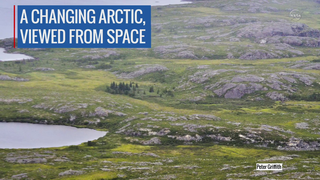Earth
ID: 13723
As Arctic summers warm, Earth's northern landscapes are changing. Using Landsat satellite data to track global tundra ecosystems over decades, a new study found the region has become greener, as warmer air and soil temperatures lead to increased plant growth.
Landsat data can be used to determine how much actively growing vegetation is on the ground – greening can represent plants growing more, becoming denser, and/or shrubs encroaching on typical tundra grasses and moss. Between 1985 and 2016, about 38% of the tundra sites across Alaska, Canada, and western Eurasia showed greening. Only 3% showed the opposite browning effect, which would mean fewer actively growing plants.
Arctic Greening Driven by Warmer Temperatures
Landsat data can be used to determine how much actively growing vegetation is on the ground – greening can represent plants growing more, becoming denser, and/or shrubs encroaching on typical tundra grasses and moss. Between 1985 and 2016, about 38% of the tundra sites across Alaska, Canada, and western Eurasia showed greening. Only 3% showed the opposite browning effect, which would mean fewer actively growing plants.
Related
Credits
Matthew R. Radcliff (USRA): Lead Producer
Aaron E. Lepsch (ADNET Systems, Inc.): Technical Support
Harrison Bach (Intern): Producer
Kate Ramsayer (Telophase): Writer
Harrison Bach (Intern): Editor
Logan Berner (Northern Arizona University): Scientist
Scott Goetz (Northern Arizona University): Scientist
Aaron E. Lepsch (ADNET Systems, Inc.): Technical Support
Harrison Bach (Intern): Producer
Kate Ramsayer (Telophase): Writer
Harrison Bach (Intern): Editor
Logan Berner (Northern Arizona University): Scientist
Scott Goetz (Northern Arizona University): Scientist
Please give credit for this item to:
NASA's Goddard Space Flight Center
NASA's Goddard Space Flight Center
Short URL to share this page:
https://svs.gsfc.nasa.gov/13723
Mission:
Landsat
This item is part of these series:
Narrated Movies
Landsat
Keywords:
DLESE >> Biology
SVS >> Landsat
GCMD >> Earth Science >> Biosphere >> Vegetation >> Vegetation Cover
SVS >> Arctic Circle
SVS >> Weather >> Seasons >> Vegetation Growth
NASA Science >> Earth
GCMD >> Earth Science >> Climate Indicators >> Land Surface/agriculture Indicators >> Vegetation Cover
GCMD keywords can be found on the Internet with the following citation: Olsen, L.M., G. Major, K. Shein, J. Scialdone, S. Ritz, T. Stevens, M. Morahan, A. Aleman, R. Vogel, S. Leicester, H. Weir, M. Meaux, S. Grebas, C.Solomon, M. Holland, T. Northcutt, R. A. Restrepo, R. Bilodeau, 2013. NASA/Global Change Master Directory (GCMD) Earth Science Keywords. Version 8.0.0.0.0
https://svs.gsfc.nasa.gov/13723
Mission:
Landsat
This item is part of these series:
Narrated Movies
Landsat
Keywords:
DLESE >> Biology
SVS >> Landsat
GCMD >> Earth Science >> Biosphere >> Vegetation >> Vegetation Cover
SVS >> Arctic Circle
SVS >> Weather >> Seasons >> Vegetation Growth
NASA Science >> Earth
GCMD >> Earth Science >> Climate Indicators >> Land Surface/agriculture Indicators >> Vegetation Cover
GCMD keywords can be found on the Internet with the following citation: Olsen, L.M., G. Major, K. Shein, J. Scialdone, S. Ritz, T. Stevens, M. Morahan, A. Aleman, R. Vogel, S. Leicester, H. Weir, M. Meaux, S. Grebas, C.Solomon, M. Holland, T. Northcutt, R. A. Restrepo, R. Bilodeau, 2013. NASA/Global Change Master Directory (GCMD) Earth Science Keywords. Version 8.0.0.0.0












